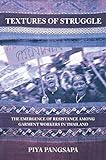Textures of Struggle : The Emergence of Resistance among Garment Workers in Thailand / Piya Pangsapa.
Material type: TextPublisher: Ithaca, NY : Cornell University Press, [2011]Copyright date: ©2011Description: 1 online resource (232 p.) : 1 table, 1 mapContent type:
TextPublisher: Ithaca, NY : Cornell University Press, [2011]Copyright date: ©2011Description: 1 online resource (232 p.) : 1 table, 1 mapContent type: - 9780801461743
- 331.4/88709593 22
- HD6073.C62 T57 2007eb
- online - DeGruyter
| Item type | Current library | Call number | URL | Status | Notes | Barcode | |
|---|---|---|---|---|---|---|---|
 eBook
eBook
|
Biblioteca "Angelicum" Pont. Univ. S.Tommaso d'Aquino Nuvola online | online - DeGruyter (Browse shelf(Opens below)) | Online access | Not for loan (Accesso limitato) | Accesso per gli utenti autorizzati / Access for authorized users | (dgr)9780801461743 |
Browsing Biblioteca "Angelicum" Pont. Univ. S.Tommaso d'Aquino shelves, Shelving location: Nuvola online Close shelf browser (Hides shelf browser)

|

|

|

|

|

|

|
||
| online - DeGruyter The Making of Minjung : Democracy and the Politics of Representation in South Korea / | online - DeGruyter Wild Yankees : The Struggle for Independence along Pennsylvania's Revolutionary Frontier / | online - DeGruyter Fading Corporatism : Israel's Labor Law and Industrial Relations in Transition / | online - DeGruyter Textures of Struggle : The Emergence of Resistance among Garment Workers in Thailand / | online - DeGruyter On Greek Religion / | online - DeGruyter Defending the Border : Identity, Religion, and Modernity in the Republic of Georgia / | online - DeGruyter The Sephardic Frontier : The "Reconquista" and the Jewish Community in Medieval Iberia / |
Frontmatter -- Contents -- Acknowledgments -- Introduction. The Condition of Women Garment Workers in Thailand -- 1. Adaptation and Accommodation: The “Nonmilitant” Women -- 2. Resistance and Worker Rebellion: The “Militant” Women -- 3. Workers in the Post-Crisis Period -- Conclusion. Looking Back, Moving Forward -- Notes -- Glossary -- Index
restricted access online access with authorization star
http://purl.org/coar/access_right/c_16ec
Based on intensive ethnographic fieldwork in Thailand, Textures of Struggle focuses on the experiences of Thai women who are employed at textile factories and examines how the all-encompassing nature of wage work speaks to issues of worker accommodation and resistance within various factory settings. Why are some women less tolerant of their working conditions than others? How is it that women who have similar levels of education, come from the same socioeconomic background, and enter the same occupation, nevertheless emerge with different experiences and reactions to their wage employment?Women in the Thai apparel industry, Piya Pangsapa finds, have very different experiences of labor "militancy" and "non-militancy." Through interviews with women at two kinds of factories—one linked to the global economy through local capital investment and another through transnational capital—Pangsapa examines issues of worker consciousness with a focus on the process by which women become activists.She explores the different degrees of control and coercion employed by factory managers and shows how women were able to overcome conditions of adversity by relying on the close personal ties they developed with each other. Textures of Struggle reveals what it is like for women to feel powerlessness and passivity in Thai sweatshops but also shows how they are equally able to resist and rebel.
Mode of access: Internet via World Wide Web.
In English.
Description based on online resource; title from PDF title page (publisher's Web site, viewed 26. Apr 2024)


